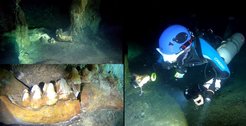Uncovering Human-Megafauna Interactions in the Drowned Caves of the Yucatan Peninsula Mexico

This project aims to apply novel methodologies such as Zooarchaeology by Mass Spectrometry (ZooMS), stable isotope analyses, radiocarbon dating, and taphonomy (including cutmark analysis, site formation studies) to megafaunal remains from the caves in the Cenote Iza, Cenote Papakal, Cenote Ziizha, Cenote Izah, Cenote San Antonio, Taj Mahal Cave, Cenote Sipa and, Cenote Las Palmas, which have not been previously applied on faunal materials from these contexts. Such work has the potential to not only massively contribute to understandings of processes of megafaunal extinction in North America, but also to assess the interactions between our species and megafauna in this region and to build up more detailed records of megafaunal chronology and ecology in a little-studied portion of the Americas.











